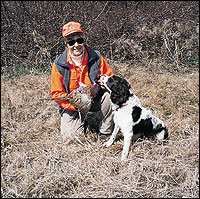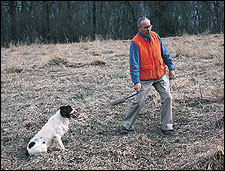By John McGonigle
 Proud moments are a lot more common with a well-conditioned, properly fed gun dog. |
Many hunters only think of conditioning their gun dogs a few weeks before hunting season. That just won't cut it.
Owners of improperly conditioned dogs think their companions let them down when the dogs run out of gas. In reality it is the owner who let the dog and the team down.
Proper conditioning is not difficult but it takes time, knowledge and a serious commitment. Here is how to correctly do it.
For a properly conditioned gun dog one must start with a healthy dog, which translates to starting with a healthy puppy. Make sure you see both parents before purchasing a pup, and be sure to check references before writing the check. Unsanitary kennel conditions, old food left in bowls and empty or dirty water bowls are all clues that perhaps you should look elsewhere for a pup. Visits to the vet will help avoid health problems that will hinder your dog's ability to be fit and to hunt at optimal levels. Vet visits twice a year are recommended.
Flea and tick control is an important aspect of conditioning, especially the latter since dogs, as well as people, can get Lyme Disease. Joint disorders and other Lyme-associated problems will prevent your dog from hunting. I have had good success with one of the flea and tick preventatives that are applied on the dog's neck/shoulder blade area. Additionally I am a believer in the Lyme vaccination, at least for dogs (and people) that live in high-risk areas. The area where I live in southeastern Pennsylvania is a Lyme disease hot spot. Discuss with your vet the benefits of giving your dog the vaccination; my vet sees about two cases of Lyme disease a week.
Kennel cleanliness is also important to keep your dog fit, since parasites will rob him of strength and health. Hose the kennel and use a strong disinfectant regularly.
An extremely important aspect of proper conditioning is nutrition. Closely related to nutrition is weight control, and it is important year round. Your dog should always be within his proper weight range and obtain all the proper nutritional elements he needs. Let's think of our gun dogs--physically at least--like human athletes. Both marathon runners and hard-working gun dogs cover a lot of miles and must be in great condition while performing. We walk straight ahead when hunting but our dog is quartering, which really racks up the miles. We often stand still, conserving energy, while our dog hunts every promising piece of thick, energy-draining cover.
Just as top human athletes cannot stay in peak physical condition all year, neither should our hunting dogs. Top athletes may carry a few extra pounds during the off season but are never excessively overweight. Gaining and losing a lot of weight takes a toll on the body--human or canine--causing chemical levels to vary widely, adversely affecting the body's physical capabilities.
During the worst of winter I allow my dogs to put on a little extra weight because they are kenneled outside during the day. Dogs should never be allowed to get fat though, no matter how or where they are kenneled. When running your hands over your dog's ribs, you should be able to feel them easily. If you can see the ribs easily he is probably a bit underweight, though many field trialers prefer to run their dogs in that condition.
Controlling your dog's weight should be easy. After all, your dog cannot pop a cold one, grab a second helping of potatoes and gravy or have a late-night bowl of ice cream. We control our dog's food intake and are directly responsible for his weight.
Do not feed your dog snacks. Feed him his one meal a day (some vets recommend two feedings daily) and be done with it. Don't melt under those soulful eyes while he watches you eat. He does not need people food and is better off without it. Don't run the risk of creating a picky eater that refuses his regular dog food. A good dry dog food will handle all your dog's nutritional needs. Speak with your vet if you feel the dog needs supplements for a specific reason. Occasionally I add some canned dog food with a lot of gravy and flavor as a treat after a hard hunt or particularly rewarding training session, although I admit that it does my mind more good than it does the dog. I never feed a dog from the counter or the dinner table--it sets a bad precedent. Dogs generally take a long time to learn something positive, but they seem to learn negative things very quickly.
Here are some physical activities that we can use to put and keep our dogs in top physical shape for hunting efficiency. Since it is August, I'll start with the exercise that is best for humans and just as good for dogs: swimming. Find water for training and conditioning purposes and you will be rewarded later during the hunting season.
While most parks with lakes or ponds allow dogs to romp, play or swim in the water, don't run afoul of legal restrictions. Stay away from people and other distractions.
Like human athletes, gun dogs need both cardiovascular and muscular conditioning. The former gives them the ability to process oxygen efficiently and pump it via a strong heart throughout their body, especially to the muscles that allow them to cover ground and bust cover. With gun dogs, good oxygen utilization is especially important because once a dog is "winded" and breathing only through his mouth, his ability to scent is seriously affected. A bird dog that cannot scent birds is of little use in the field.
 Ed Berger of Harleysville, Pennsylvania, conditions a springer with land retrieves. |
A good way to exercise your dog in hot weather is through repetitive water retrieves. Do not overwhelm him initially, but give him enough retrieves to get him breathing heavily. As the month goes on, add numbers and distance to the retrieves. The cooling properties of the water will allow you to work your dog more in the water than you can on land in hot weather.
Toward the end of August, start mixing land and water retrieves for further conditioning and to strengthen his running muscles. It is almost time for doves and, soon thereafter, upland game. By the first week of September you should be taking your dog out two or three mornings a week, starting with a 15- to 20-minute run. Mornings may be tough on you, but they are a lot better for the dog since afternoons and evenings may still be plenty hot. Using your judgment, increase the time and distance to raise the dog's level of conditioning, and yours.
Depending on where you live, you can "road" your springer from a 4-wheeler or a bicycle. Yes, I know that is more commonly done with pointing dogs, but you can't tell that to Paul Harris, a flushing dog pro from New Jersey who rigs his 4-wheeler to handle four dogs at once. I also remember seeing a photo of Roy French, legendary springer field-trialer, roading spaniels from his 4-wheeler when he was near 90.
Another roading technique adopted from the pointing-dog folks is using a roading harness. I have used one off and on, and the dogs seem to enjoy it. Put the harness on the dog and walk him, by moving just a bit slower than he wants to. Let him pull hard so that he builds chest, leg and haunch muscles. Start with a short distance and increase it as warranted. You will be surprised at how a roading harness can add muscle to a dog with consistent use.
Another way to muscle him up and increase cardiovascular fitness is to toss training dummies up a hill for him to retrieve. Any of you remember running wind sprints up the hill for your old football coach? It works for dogs, too.
Dog owners that participate in the various forms of hunt tests tend to keep their dogs in better shape than hunters who do not. Hunt tests are an impetus for continued training and conditioning, forcing you to work with your hunting buddy all year.
Make sure you have plenty of water along and give it to your dog freely while training or hunting. Give your dog water prior to a hard training or hunting session. For a break, let your dog lay in any available water while hunting, training or conditioning him.
I occasionally hear someone say, "my dog can hunt all day." In most cases, I doubt it. The hunters I know have to make a living, so the time they devote to training and conditioning is limited. Before you push your dog long or hard when hunting, ask yourself if you've really conditioned him properly. Do you think it is fair to push him past his physical limits? Those limits are determined in large part by the time you spent with him in the field before and after the season. Do you think it's fair to run him so hard on Saturday that he barely moves again until Tuesday? I don't!
How long would it take you to prepare for a marathon? How many days, weeks and months would you spend running, dieting and lifting weights? Now, be fair to your dog. Remember, he's an athlete like you.
A dog that can hunt hard and find birds for an hour and a half is doing a good job. Rest him for five to 10 minutes after working a particular piece of cover. Use a second dog, and rest the first one before putting him down again. Another short run would make a pretty good day for most dogs.
Start conditioning your dog today. Hunting is supposed to be fun for you and the dog. Getting him (and you) in shape will help to reach that goal.






